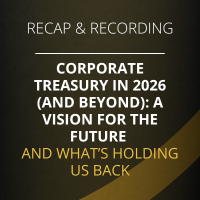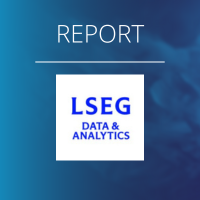Plans & Experiences with AI in Cash Forecasting
By ComplexCountries
In the CXC poll on the use of AI in cash forecasting ten percent of respondents said they were using AI in their cash forecasting and a further 17% have plans to do so. Sixty seven percent are interested in AI for forecasting but have no plans in place and only seven percent are not interested.

Artificial Intelligence – AI – is very much the rage. Admittedly, this peer discussion was about AI in cash forecasting, but it left the very real impression that every participant felt the need to have an AI story. In most cases, this lies somewhere in the future: while some people are quite advanced, for most, it is a work in progress.
Cash forecasting is the thing all treasurers complain about: it is rarely accurate, and usually involves a lot of effort. There are good reasons for this: more on that below. There are also different approaches:
- The traditional difference between long term (balance sheet to balance sheet) and short term, usually done by mapping out receipts and disbursements.
- For receipts and disbursements, approaches vary between looking at all the customer and supplier invoices coming due, and looking at historical trends. Both approaches involve huge amounts of number crunching – usually done manually.
- Other data has to be incorporated: bank balances (hopefully up to date!), the I&E forecast, the impact of cash pooling, etc.
- In addition, this forecast can be impacted by single events: whether a major customer pays or not, the impact of large supplier discounts, whether or not funding is completed, the timing of a large tax payment – to name just a few.
However you approach it, cash forecasting is ideally suited to AI: a lot of data has to be processed from different sources, brought together, and then subjected to scenario and reasonableness testing. Of our participants:
- Three had real experience of working AI based projects. The situation improved considerably – though, for one, the loss of the graduate working on the project meant a return to the status quo.
- The company of one participant decided to implement S4/Hana with AI, but then did not go ahead with the AI based cash forecasting, as the data in the system was not clean.
- The others are all moving towards implementing systems – usually a TMS – with AI capabilities for cash forecasting. FIS Integrity and Cashforce (TIS) received positive comments. Kyriba’s AI cash forecasting module was generally deemed too complicated: one installed the Kyriba TMS, but used Integrity for forecasting. One participant is exploring Microsoft’s AI tools, and one had also looked at a tool provided by JPMorgan using past collections to predict the future.
- All seemed to be taking the customer receivables files by invoice, looking at the due date, and then calculating the likely date of receipt by applying the customer’s historical payment timeliness. Still, accuracy remained an issue.
- It was generally felt that the due date in the system for paying suppliers was a good guide to the date of actual cash outflows, though there were some issues with supplier discounts not being input until the end.
- In all cases, treasurers found issues with the quality of the data in the ERP system. Cleaning the data improved the cash forecasts.
- Most participants voiced concern about using historical data to make forecasts: history does not cater for changes in customer mix, issues in the economy, M&A etc.
- The level of urgency applied to these projects varied, but it was only a top priority for the company in a couple of cases. Most companies survive, even with poor cash forecasts: so why devote significant resources to something which is not essential?
- The organisational responsibility for cash forecasting was not a specified discussion topic, but, from the comments, it seemed to vary. It was not unusual for the cash forecast to be prepared by the operating units, and consolidated by the centre, who usually did not feel it was their role to challenge the input. In one case, different business units had implemented different IT solutions. This is probably not optimal. In one case, the cash forecast is prepared by financial planning.
- Some companies stated that forecast accuracy and quality varied by business unit: the ones who paid more attention got better results.
Finally, a couple of words on why cash forecasting is such a problem for treasurers. Some, but not all, of these items here were mentioned in the call, but a quick recap helps to add some perspective:
- A cash forecast is more difficult to prepare than a revenue and profit outlook. The cash situation is the result of many movements in and out – revenue and profit depend on fewer variables.
- As usual, participants in the call focused on customer receivables and supplier payments. But there are many other flows which affect the cash position: tax is one – VAT, in particular, often reserves large surprises. Even payroll can surprise, especially when large bonuses or payroll taxes have to be paid.
- If a company is in a good financial situation, a cash forecast is good to have, but not essential. It only becomes essential when cash is very tight. This was reflected in the call – and in the level of focus within the company.
- The financial benefit of investing in a good cash forecast is to improve investment income or reduce interest expense through a better management of borrowing and investment maturities. This benefit declines when interest rates go down – and most companies will always keep a buffer.
- A big factor in cash forecasting is working capital management. Treasurers are not always deeply involved in this, and often have a limited ability to influence it.
- As every participant stated, GIGO (Garbage In, Garbage Out) very much applies. All have found limitations in their ability to exploit ERP systems due to poor data quality. AI can help detect anomalies, but there is still a lot of work to do to address them.
Bottom line: AI is making its entry into the world of treasury via cash forecasting. There is no doubt it will bring significant benefits, and some of our participants have already seen them.
But challenges remain: it is an inherently difficult exercise, AI implementation is costly, and a significant effort is required to clean up the data in the system. Even then, historical patterns need to be applied judiciously. AI helps – but the foundation needs to be there.
The detailed 18 page report in available to premium subscribers only – please enquire here about our subscription options.
Access to the full report is available to Premium Subscribers of ComplexCountries. Please log in on the website of ComplexCountries to access the download.
Please contact ComplexCountries to find out about their subscription packages.
Can’t get enough? Check out these latest items
 https://treasuryxl.com/wp-content/uploads/2023/03/Treasurer-Search-Logo.png
200
200
treasuryXL
https://treasuryxl.com/wp-content/uploads/2018/07/treasuryXL-logo-300x56.png
treasuryXL2025-12-30 09:19:492025-12-30 09:19:49Business Treasurer @Treasurer Search
https://treasuryxl.com/wp-content/uploads/2023/03/Treasurer-Search-Logo.png
200
200
treasuryXL
https://treasuryxl.com/wp-content/uploads/2018/07/treasuryXL-logo-300x56.png
treasuryXL2025-12-30 09:19:492025-12-30 09:19:49Business Treasurer @Treasurer Search https://treasuryxl.com/wp-content/uploads/2025/12/Copy-of-Live-Session-Nomentia-1.png
200
200
treasuryXL
https://treasuryxl.com/wp-content/uploads/2018/07/treasuryXL-logo-300x56.png
treasuryXL2025-12-19 08:49:372025-12-19 09:41:43Recap & Recording: Corporate Treasury in 2026 and beyond
https://treasuryxl.com/wp-content/uploads/2025/12/Copy-of-Live-Session-Nomentia-1.png
200
200
treasuryXL
https://treasuryxl.com/wp-content/uploads/2018/07/treasuryXL-logo-300x56.png
treasuryXL2025-12-19 08:49:372025-12-19 09:41:43Recap & Recording: Corporate Treasury in 2026 and beyond https://treasuryxl.com/wp-content/uploads/2024/01/Template_VACANCY-featured.png
200
200
treasuryXL
https://treasuryxl.com/wp-content/uploads/2018/07/treasuryXL-logo-300x56.png
treasuryXL2025-12-19 08:20:412025-12-19 08:20:41Vacancy Service Operations Manager (Treasury Tech) – Vienna
https://treasuryxl.com/wp-content/uploads/2024/01/Template_VACANCY-featured.png
200
200
treasuryXL
https://treasuryxl.com/wp-content/uploads/2018/07/treasuryXL-logo-300x56.png
treasuryXL2025-12-19 08:20:412025-12-19 08:20:41Vacancy Service Operations Manager (Treasury Tech) – Vienna https://treasuryxl.com/wp-content/uploads/2025/12/FinanceKey-Featured-1.png
200
200
treasuryXL
https://treasuryxl.com/wp-content/uploads/2018/07/treasuryXL-logo-300x56.png
treasuryXL2025-12-18 07:00:142025-12-18 18:17:55Pivoting in FinanceKey: turn raw data into instant insight
https://treasuryxl.com/wp-content/uploads/2025/12/FinanceKey-Featured-1.png
200
200
treasuryXL
https://treasuryxl.com/wp-content/uploads/2018/07/treasuryXL-logo-300x56.png
treasuryXL2025-12-18 07:00:142025-12-18 18:17:55Pivoting in FinanceKey: turn raw data into instant insight https://treasuryxl.com/wp-content/uploads/2025/08/LSEG-BLOGS-featured-10.png
200
200
treasuryXL
https://treasuryxl.com/wp-content/uploads/2018/07/treasuryXL-logo-300x56.png
treasuryXL2025-12-17 07:00:252025-12-16 08:55:07Test Data as a Service
https://treasuryxl.com/wp-content/uploads/2025/08/LSEG-BLOGS-featured-10.png
200
200
treasuryXL
https://treasuryxl.com/wp-content/uploads/2018/07/treasuryXL-logo-300x56.png
treasuryXL2025-12-17 07:00:252025-12-16 08:55:07Test Data as a Service https://treasuryxl.com/wp-content/uploads/2023/03/Treasurer-Search-Logo.png
200
200
treasuryXL
https://treasuryxl.com/wp-content/uploads/2018/07/treasuryXL-logo-300x56.png
treasuryXL2025-12-16 09:27:252025-12-16 09:27:25Interim Treasury Manager @ Treasurer Search
https://treasuryxl.com/wp-content/uploads/2023/03/Treasurer-Search-Logo.png
200
200
treasuryXL
https://treasuryxl.com/wp-content/uploads/2018/07/treasuryXL-logo-300x56.png
treasuryXL2025-12-16 09:27:252025-12-16 09:27:25Interim Treasury Manager @ Treasurer Search https://treasuryxl.com/wp-content/uploads/2025/06/Nirav-Interview-1.png
200
200
treasuryXL
https://treasuryxl.com/wp-content/uploads/2018/07/treasuryXL-logo-300x56.png
treasuryXL2025-12-16 07:00:212025-12-15 12:30:31Stablecoins: The Silent Revolution Is Already Here
https://treasuryxl.com/wp-content/uploads/2025/06/Nirav-Interview-1.png
200
200
treasuryXL
https://treasuryxl.com/wp-content/uploads/2018/07/treasuryXL-logo-300x56.png
treasuryXL2025-12-16 07:00:212025-12-15 12:30:31Stablecoins: The Silent Revolution Is Already Here https://treasuryxl.com/wp-content/uploads/2024/02/Featured_Treasurer-Search.png
200
200
treasuryXL
https://treasuryxl.com/wp-content/uploads/2018/07/treasuryXL-logo-300x56.png
treasuryXL2025-12-15 07:00:062025-12-19 08:28:55The Future of Financial Messaging: Migrating from MT940 to ISO 20022
https://treasuryxl.com/wp-content/uploads/2024/02/Featured_Treasurer-Search.png
200
200
treasuryXL
https://treasuryxl.com/wp-content/uploads/2018/07/treasuryXL-logo-300x56.png
treasuryXL2025-12-15 07:00:062025-12-19 08:28:55The Future of Financial Messaging: Migrating from MT940 to ISO 20022 https://treasuryxl.com/wp-content/uploads/2025/09/Nomentia-BLOGS-featured-5.png
200
200
treasuryXL
https://treasuryxl.com/wp-content/uploads/2018/07/treasuryXL-logo-300x56.png
treasuryXL2025-12-12 12:54:092025-12-12 13:07:57Nomentia Announces Leadership Transition to Drive Next Phase of Growth
https://treasuryxl.com/wp-content/uploads/2025/09/Nomentia-BLOGS-featured-5.png
200
200
treasuryXL
https://treasuryxl.com/wp-content/uploads/2018/07/treasuryXL-logo-300x56.png
treasuryXL2025-12-12 12:54:092025-12-12 13:07:57Nomentia Announces Leadership Transition to Drive Next Phase of Growth


